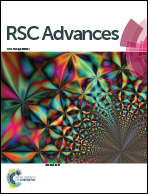Preparation of a stable superhydrophobic boat for efficient separation and removal of oil from water
Abstract
In this work, a Fe2O3@fabric composite was prepared via a process combining Fenton's and Schiff base reactions. The as-prepared surface exhibited superhydrophobic and superoleophilic properties simultaneously, with a high water contact angle of 160.2° and an oil contact angle of nearly 0°. The superhydrophobic surface possessed good mechanical stability, due to the fact that the surface could maintain superhydrophobicity after mechanical abrasion of 700 mm, and was torn by tape over 50 times. In addition, the composite fabric demonstrated highly efficient oil–water separation because of its extreme superhydrophobicity–superoleophilicity wettability. Inspired by water striders, a mini boat was made for self-driven, oil spill clean-up. We expect that this robust fabric will be widely adopted for application in oil–water separation and oil absorption.


 Please wait while we load your content...
Please wait while we load your content...